
Continental Europe or mainland Europe is the contiguous continent of Europe, excluding its surrounding islands. It can also be referred to ambiguously as the European continent, – which can conversely mean the whole of Europe – and, by some, simply as the Continent. When Eurasia is regarded as a single continent, Europe is treated as a subcontinent, and called the European subcontinent.

Orkney, also known as the Orkney Islands, is an archipelago in the Northern Isles of Scotland, situated off the north coast of the island of Great Britain. Orkney is 10 miles (16 km) north of the coast of Caithness and has about 70 islands, of which 20 are inhabited. The largest island, the Mainland, has an area of 523 square kilometres (202 sq mi), making it the sixth-largest Scottish island and the tenth-largest island in the British Isles. Orkney's largest settlement, and also its administrative centre, is Kirkwall.

Southeast Asia, also spelled South East Asia and South-East Asia, and also known as Southeastern Asia, South-eastern Asia or SEA, is the geographical south-eastern region of Asia, consisting of the regions that are situated south of mainland China, east of the Indian subcontinent, and north-west of mainland Australia which is part of Oceania. Southeast Asia is bordered to the north by East Asia, to the west by South Asia and the Bay of Bengal, to the east by Oceania and the Pacific Ocean, and to the south by Australia and the Indian Ocean. Apart from the British Indian Ocean Territory and two out of 26 atolls of Maldives in South Asia, Maritime Southeast Asia is the only other subregion of Asia that lies partly within the Southern Hemisphere. Mainland Southeast Asia is completely in the Northern Hemisphere. Timor-Leste and the southern portion of Indonesia are the only parts in Southeast Asia that are south of the Equator.

Zanzibar is an insular semi-autonomous province which united with Tanganyika in 1964 to form the United Republic of Tanzania. It is an archipelago in the Indian Ocean, 25–50 km (16–31 mi) off the coast of the African mainland, and consists of many small islands and two large ones: Unguja and Pemba Island. The capital is Zanzibar City, located on the island of Unguja. Its historic centre, Stone Town, is a World Heritage Site.

The tourism industry has been an important part of the economy of Hong Kong since it shifted to a service sector model in the late 1980s and early 90s. There has been a sharp increase of domestic tourists from Mainland China following the introduction of the Individual Visit Scheme (IVS) in 2003.
Affluenza is a pseudoscientific psychological malaise supposedly affecting wealthy people. It is a portmanteau of affluence and influenza, and is used most commonly by critics of consumerism. It is not a medically recognized disease. The word is thought to have been first used in 1954, but was popularised in 1997 with a PBS documentary of the same name and the subsequent book Affluenza: The All-Consuming Epidemic. These works define affluenza as "a painful, contagious, socially transmitted condition of overload, debt, anxiety, and waste resulting from the dogged pursuit of more". A more informal definition of the term would describe it as "a quasi-illness caused by guilt for one's own socio-economic superiority". The term "affluenza" has also been used to refer to an inability to understand the consequences of one's actions because of financial privilege.

Fennoscandia, or the Fennoscandian Peninsula, is the geographical peninsula in Europe which includes the Scandinavian and Kola peninsulas, mainland Finland, and Karelia. Administratively, this roughly encompasses the mainlands of Finland, Norway and Sweden, as well as Murmansk Oblast, much of the Republic of Karelia, and parts of northern Leningrad Oblast in Russia.

Dogger Bank is a large sandbank in a shallow area of the North Sea about 100 kilometres (62 mi) off the east coast of England.

Land's End Airport, situated near St Just in Penwith, 5 NM west of Penzance, in Cornwall, is the most south westerly airport of mainland Britain. The airport is owned by the Isles of Scilly Steamship Company (ISSC). ISSC's subsidiary Land's End Airport Limited operates the airport, and another subsidiary, Isles of Scilly Skybus, operates a regular passenger service to St Mary's in the Isles of Scilly as well as scenic flights around west Penwith.

Australia, officially the Commonwealth of Australia, is a sovereign country comprising the mainland of the Australian continent, the island of Tasmania, and numerous smaller islands. Australia is the largest country by area in Oceania and the world's sixth-largest country. Australia is the oldest, flattest, and driest inhabited continent, with the least fertile soils. It is a megadiverse country, and its size gives it a wide variety of landscapes and climates, with deserts in the centre, tropical rainforests in the north-east, tropical savannas in the north, and mountain ranges in the south-east.

The Peugeot 108 is a city car launched by French manufacturer Peugeot in March 2014 at the Geneva Motor Show. The 108 is related to the Citroën C1 and Toyota Aygo, and shares their floorpan, engines, transmission and electrics. Sales commenced in June 2014 in Mainland Europe and in July 2014 in the United Kingdom.
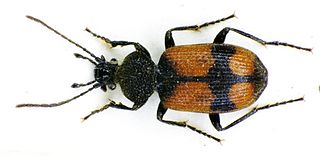
Panagaeus cruxmajor, the crucifix ground beetle, is a rare European ground beetle. In England it occurs in a few places only. Panagaeus bipustulatus is a commoner relative, looking very much alike except for being smaller. The crucifix ground beetle is sometimes included in P. bipustulatus, but most modern authors consider it distinct.

East Asia is the easternmost region of Asia, which is defined in both geographical and ethno-cultural terms. The modern states of East Asia include China, Japan, Mongolia, North Korea, South Korea, and Taiwan. Hong Kong and Macau, two small coastal quasi-dependent territories located in the south of China, are officially highly autonomous but are under Chinese sovereignty. Japan, Taiwan, South Korea, Mainland China, Hong Kong, and Macau are among the world's largest and most prosperous economies. East Asia borders Siberia and the Russian Far East to the north, Southeast Asia to the south, South Asia to the southwest, and Central Asia to the west. To the east is the Pacific Ocean and to the southeast is Micronesia.
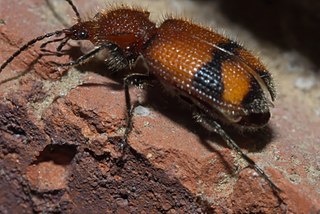
Panagaeus is a genus in the beetle family Carabidae, native to the Holarctic, the Near East, and North Africa, as well as Central and South America. There are about 15 described species in Panagaeus.
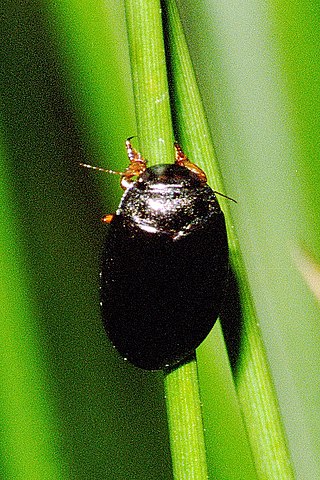
Agabus bipustulatus is a species of beetle native to the Palearctic, the Afro-tropical region, the Near East and North Africa. In Europe, it is found everywhere except in several small countries and islands: the Canary Islands, Franz Josef Land, Gibraltar, Madeira, Malta, Moldova, Monaco, the North Aegean Islands, Novaya Zemlya, San Marino, the Selvagens Islands, Svalbard and Jan Mayen, and Vatican City.
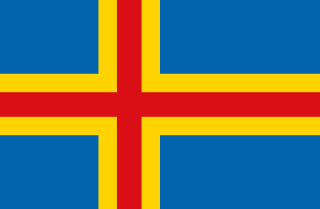
Åland is an autonomous and demilitarised region of Finland since 1920 by a decision of the League of Nations. It is the smallest region of Finland by area and population, with a size of 1,580 km2, and a population of 30,129, constituting 0.51% of its land area and 0.54% of its population. Its only official language is Swedish and the capital city is Mariehamn.
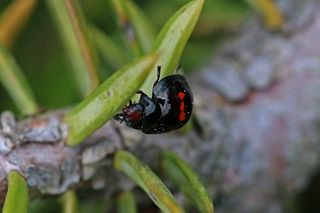
Chilocorus bipustulatus, the heather ladybird, is a beetle species belonging to the family Coccinellidae, subfamily Chilocorinae.

Relations between people in Hong Kong and mainland China have been relatively tense since the early 2000s. Various factors have contributed, including different interpretations of the "one country, two systems" principle; policies of the Hong Kong and central governments to encourage mainland visitors to Hong Kong; and the changing economic environment. More broadly, there exists resentment toward mainland-Hong Kong convergence and assimilation, as well as the increasing interference from the government of China and its ruling Chinese Communist Party (CCP) in Hong Kong's internal affairs.
Southeast Asia was first reached by anatomically modern humans in two distinct waves before 50,000 years ago, possibly firstly before 70,000 years ago. Anatomically modern humans are suggested to have reached Southeast Asia twice in the course of the Southern Dispersal migrations during and after the formation of a distinct East Asian clade, at around 50,000 years ago.

















